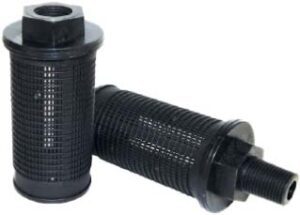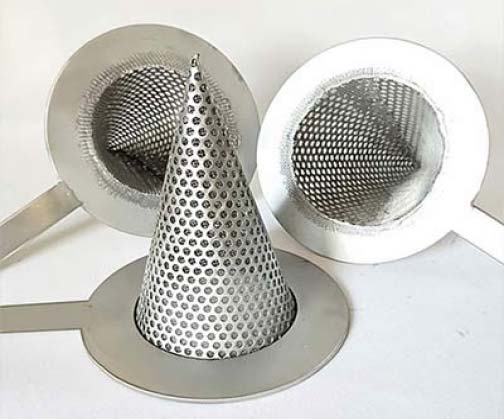How Dirt Levels Affect Hydraulic System Performance…Continued
 What do we know about this guy, the enemy of all hydraulic systems? Dirt particles that cause trouble in a hydraulic system are extremely small. Typically, 98 percent of hydraulic fluid contains particles so small that we cannot see them without magnification. Fluid samples from operating systems show us that, as the size of a particle decreases, its quantity increases. In other words, the smaller the particles, the more there are in a given volume of fluid. Filters are the only available means of controlling the overall level when such small particles are involved. However, before we can begin to eliminate hazardous dirt levels and contaminants, it is first necessary to understand the source.
What do we know about this guy, the enemy of all hydraulic systems? Dirt particles that cause trouble in a hydraulic system are extremely small. Typically, 98 percent of hydraulic fluid contains particles so small that we cannot see them without magnification. Fluid samples from operating systems show us that, as the size of a particle decreases, its quantity increases. In other words, the smaller the particles, the more there are in a given volume of fluid. Filters are the only available means of controlling the overall level when such small particles are involved. However, before we can begin to eliminate hazardous dirt levels and contaminants, it is first necessary to understand the source.
How does dirt get into a closed system?
Since hydraulic systems are closed and the same fluid is continually recirculated, you may wonder how dirt gets in. As an aid to understanding the basic problem, let’s examine some of the most common sources of contaminants that contribute to higher levels of dirt in a fluid power system.
- Built-in Dirt. Specifically, core sand, weld splatter, metal chips, lint, and abrasive dust are all considered built-in contaminants. Also, the initial fluid introduction before the system and equipment is turned on, will contain a certain amount of fine particles of contamination.
- Introduced Contaminants. These are particles that enter through the seals, fluid filter tubes, and breather caps, or when the system is open for component repair or replacement. Here, too, if fluid is added to replenish the reservoir supply, it will contain particle contaminants which are introduced into the system.
- Internally Generated Particles. Wear from system components also contribute to the presence of contamination. Friction of moving parts gradually produces small particles of metal and sealing materials, continuously adding to the particle count in the fluid.
- Fluid Breakdown. When chemical reactions occur within the fluid itself, the result is usually in the form of sludge and acids. Although not generally abrasive, sludge is a source of resinous coatings on moving parts, slowing movement and clogging passages. Acid, however, can pit and corrode vital internal parts.
 Cross Reference Guide
Cross Reference Guide
 Cross Reference Guide
Cross Reference Guide Hydraulic systems should be designed for effective, smooth operation. Adequate filtration becomes a primary concern to fulfill that operation. In addition to having proper filtration throughout the system, wisdom is that it starts at the pump. After all, the pump is the most critical component in the system because if it stops working, the system stops. That means out of operation. Therefore, protecting the pump is most important. Pumps are made to take a beating but you need to keep larger particles from passing through. If filtration is too restrictive at the pump it could cause cavitation to occur and that could be catastrophic. Too many operators ignore the condition of the pump until it starts making noise. By then it is too late. We encourage the use of suction strainers to protect the system’s operation at the onset.
Hydraulic systems should be designed for effective, smooth operation. Adequate filtration becomes a primary concern to fulfill that operation. In addition to having proper filtration throughout the system, wisdom is that it starts at the pump. After all, the pump is the most critical component in the system because if it stops working, the system stops. That means out of operation. Therefore, protecting the pump is most important. Pumps are made to take a beating but you need to keep larger particles from passing through. If filtration is too restrictive at the pump it could cause cavitation to occur and that could be catastrophic. Too many operators ignore the condition of the pump until it starts making noise. By then it is too late. We encourage the use of suction strainers to protect the system’s operation at the onset. We manufacture suction strainers for applications from 3 gpm to 400 gpm and with 30, 60, 100, or 200 stainless steel wire mesh media being standard. We can customize suction strainers using many varying mesh sizes and materials, meeting your exacting specifications. We help your hydraulic systems continue to run smoothly. Click on the following link and begin scrolling to view our standard product line, if you do not see what you need, please reach out and our Sales Team will be ready and willing to help! Contact us anytime. We are always willing to assist!
We manufacture suction strainers for applications from 3 gpm to 400 gpm and with 30, 60, 100, or 200 stainless steel wire mesh media being standard. We can customize suction strainers using many varying mesh sizes and materials, meeting your exacting specifications. We help your hydraulic systems continue to run smoothly. Click on the following link and begin scrolling to view our standard product line, if you do not see what you need, please reach out and our Sales Team will be ready and willing to help! Contact us anytime. We are always willing to assist!
 What do we know about this guy, the enemy of all hydraulic systems? Dirt particles that cause trouble in a hydraulic system are extremely small. Typically, 98 percent of hydraulic fluid contains particles so small that we cannot see them without magnification. Fluid samples from operating systems show us that, as the size of a particle decreases, its quantity increases. In other words, the smaller the particles, the more there are in a given volume of fluid. Filters are the only available means of controlling the overall level when such small particles are involved. However, before we can begin to eliminate hazardous dirt levels and contaminants, it is first necessary to understand the source.
What do we know about this guy, the enemy of all hydraulic systems? Dirt particles that cause trouble in a hydraulic system are extremely small. Typically, 98 percent of hydraulic fluid contains particles so small that we cannot see them without magnification. Fluid samples from operating systems show us that, as the size of a particle decreases, its quantity increases. In other words, the smaller the particles, the more there are in a given volume of fluid. Filters are the only available means of controlling the overall level when such small particles are involved. However, before we can begin to eliminate hazardous dirt levels and contaminants, it is first necessary to understand the source. We also are masters at manufacturing custom filters. These specific strainers are also referred to as “cone” or “witches’ hat” strainers. They are primarily used for new pipeline start-up or where there is minimal solids loading. They protect costly components and equipment. They are usually not meant to be permanent strainers and are removed from the pipeline after initial start-up.
We also are masters at manufacturing custom filters. These specific strainers are also referred to as “cone” or “witches’ hat” strainers. They are primarily used for new pipeline start-up or where there is minimal solids loading. They protect costly components and equipment. They are usually not meant to be permanent strainers and are removed from the pipeline after initial start-up.